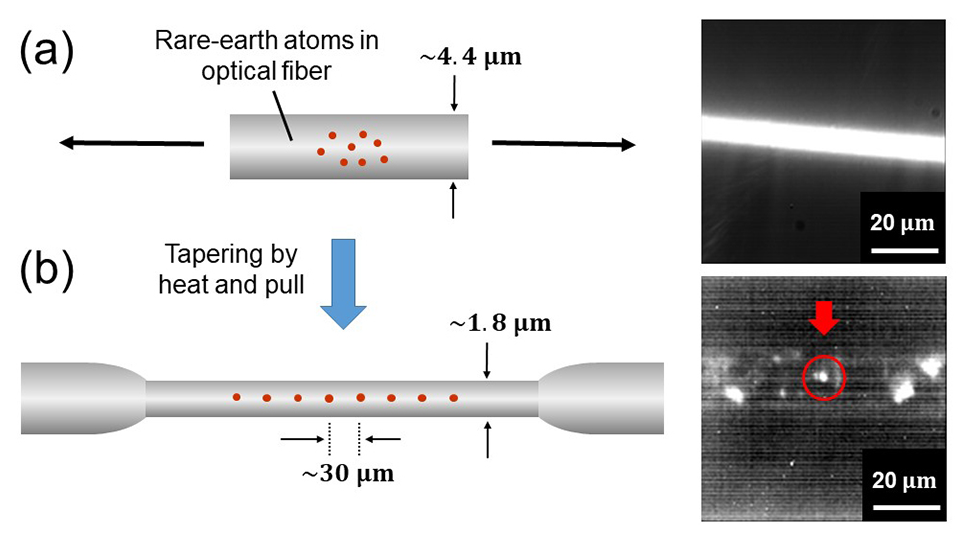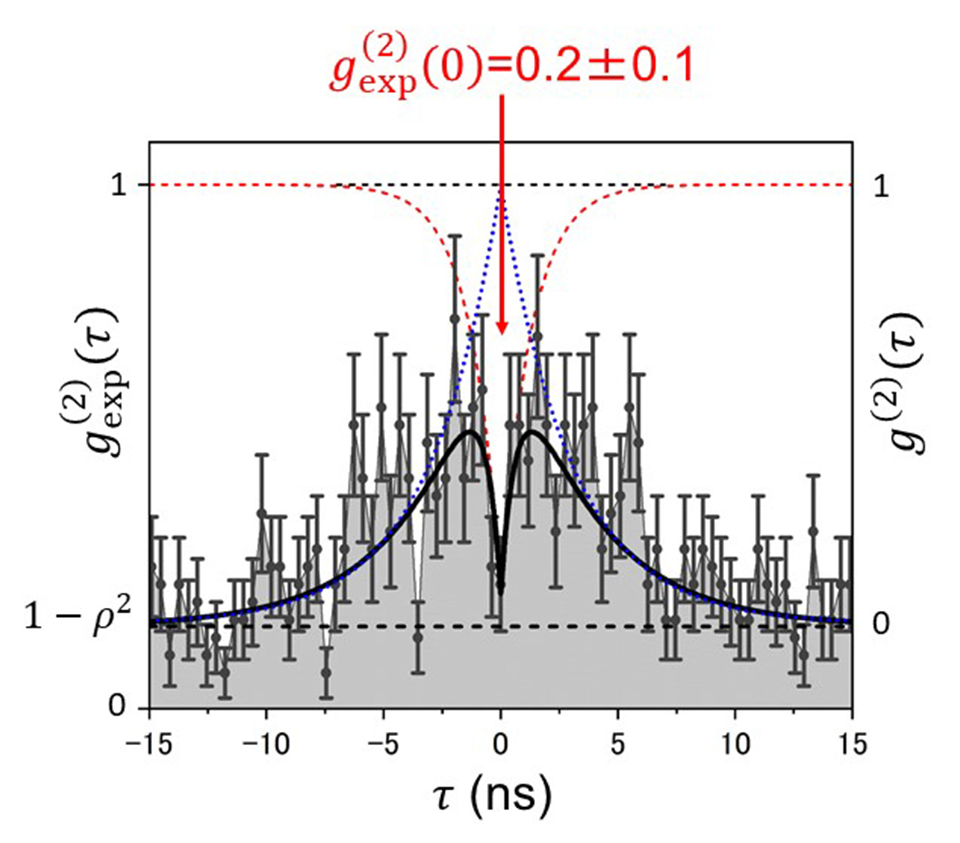2023.11.02 Thursday
Optical-Fiber based Single-Photon Light Source at Room Temperature for Next-Generation Quantum Processing
Ytterbium-doped optical fibers are expected to pave the way for cost-effective quantum technologies

Quantum-based systems promise faster computing and stronger encryption for computation and communication systems. These systems can be built on fiber networks involving interconnected nodes which consist of qubits and single-photon generators that create entangled photon pairs.
In this regard, rare-earth (RE) atoms and ions in solid-state materials are highly promising as single-photon generators. These materials are compatible with fiber networks and emit photons across a broad range of wavelengths. Due to their wide spectral range, optical fibers doped with these RE elements could find use in various applications, such as free-space telecommunication, fiber-based telecommunications, quantum random number generation, and high-resolution image analysis. However, so far, single-photon light sources have been developed using RE-doped crystalline materials at cryogenic temperatures, which limits the practical applications of quantum networks based on them.
In a study published in Volume 20, Issue 4 of the journal Physical Review Applied on 16 October 2023, a team of researchers from Japan, led by Associate Professor Kaoru Sanaka from Tokyo University of Science (TUS) has successfully developed a single-photon light source consisting of doped ytterbium ions (Yb3+) in an amorphous silica optical fiber at room temperature. Associate Professor Mark Sadgrove and Mr. Kaito Shimizu from TUS and Professor Kae Nemoto from the Okinawa Institute of Science and Technology Graduate University were also a part of this study. This newly developed single-photon light source eliminates the need for expensive cooling systems and has the potential to make quantum networks more cost-effective and accessible.
"Single-photon light sources are devices that control the statistical properties of photons, which represent the smallest energy units of light," explains Dr. Sanaka. "In this study, we have developed a single-photon light source using an optical fiber material doped with optically active RE elements. Our experiments also reveal that such a source can be generated directly from an optical fiber at room temperature."
Ytterbium is an RE element with favorable optical and electronic properties, making it a suitable candidate for doping the fiber. It has a simple energy-level structure, and ytterbium ion in its excited state has a long fluorescence lifetime of around one millisecond.
To fabricate the ytterbium-doped optical fiber, the researchers tapered a commercially available ytterbium-doped fiber using a heat-and-pull technique, where a section of the fiber is heated and then pulled with tension to gradually reduce its diameter.
Within the tapered fiber, individual RE atoms emit photons when excited with a laser. The separation between these RE atoms plays a crucial role in defining the fiber's optical properties. For instance, if the average separation between the individual RE atoms exceeds the optical diffraction limit, which is determined by the wavelength of the emitted photons, the emitted light from these atoms appears as though it is coming from clusters rather than distinct individual sources.
To confirm the nature of these emitted photons, the researchers employed an analytical method known as autocorrelation, which assesses the similarity between a signal and its delayed version. By analyzing the emitted photon pattern using autocorrelation, the researchers observed non-resonant emissions and further obtained evidence of photon emission from the single ytterbium ion in the doped filter.
While quality and quantity of emitted photons can be enhanced further, the developed optical fiber with ytterbium atoms can be manufactured without the need for expensive cooling systems. This overcomes a significant hurdle and opens doors to various next-generation quantum information technologies. "We have demonstrated a low-cost single-photon light source with selectable wavelength and without the need for a cooling system. Going ahead, it can enable various next-generation quantum information technologies such as true random number generators, quantum communication, quantum logic operations, and high-resolution image analysis beyond the diffraction limit," concludes Dr. Sanaka.

Image title: Construction of tapered rare-earth atom-doped optical fiber.
Image caption: (a) Schematic diagram and microscopic observation of an optical fiber doped with rare-earth atoms. The fluorescence from the entire optical fiber can be seen. (b) Schematic diagram and microscopic observation of the optical fiber after heat and pull processing. Fluorescence from a single rare-earth atom isolated in the optical fiber can be seen.
Image credit: Kaoru Sanaka from TUS, Japan
License type: Original Content
Usage restrictions: Cannot be reused without permission

Image title: Second-order autocorrelation measurement results for delay time.
Image caption: When the delay time is zero, single-photon emission is seen. The value is less than 0.5 when the delay time is zero.
Image credit: Kaoru Sanaka from TUS, Japan
License type: Original Content
Usage restrictions: Cannot be reused without permission
Reference
| Title of original paper | : | Room-temperature addressing of single rare-earth atoms in optical fiber |
| Journal | : | Physical Review Applied |
| DOI | : | 10.1103/PhysRevApplied.20.044038 |
About The Tokyo University of Science
Tokyo University of Science (TUS) is a well-known and respected university, and the largest science-specialized private research university in Japan, with four campuses in central Tokyo and its suburbs and in Hokkaido. Established in 1881, the university has continually contributed to Japan's development in science through inculcating the love for science in researchers, technicians, and educators.
With a mission of "Creating science and technology for the harmonious development of nature, human beings, and society," TUS has undertaken a wide range of research from basic to applied science. TUS has embraced a multidisciplinary approach to research and undertaken intensive study in some of today's most vital fields. TUS is a meritocracy where the best in science is recognized and nurtured. It is the only private university in Japan that has produced a Nobel Prize winner and the only private university in Asia to produce Nobel Prize winners within the natural sciences field.
■
Tokyo University of Science(About TUS)

About Associate Professor Kaoru Sanaka
from Tokyo University of Science
Kaoru Sanaka is an Associate Professor at the Department of Physics of the Faculty of Science Division I at Tokyo University of Science. He holds a Ph.D. from The University of Tokyo and specializes in Quantum Optics, Quantum Electronics, and Quantum Information Science. He has published over 30 research articles on these topics, which have received more than 1,000 citations. He was awarded the Lise Meitner Fellow award in 2002.
Laboratory website 
Official TUS website 
About Associate Professor
Mark Paul Sadgrove
from Tokyo University of Science
Funding information
This work was supported by Tokyo University of Science Research Grant and JST Grant-in-Aid for Scientific Research (C) Grant No. 21K04931.

